Richard Séguin refers to his city, Quebec City, as a large village. When Amy Hartell and I arrived at the small Quebec City Airport—our first visit—we thought the city would reflect the size of the airport. The taxi drive to our Le Chateau Frontenac accommodations quelled that analogy immediately. Quebec City is a quietly robust city of one-half million-an Old World city blended with the New World. It is two-tier city, one called Old Quebec and the other New Quebec. Staying in Old Quebec, at week's end, we understood Séguin's assessment perfectly |
|
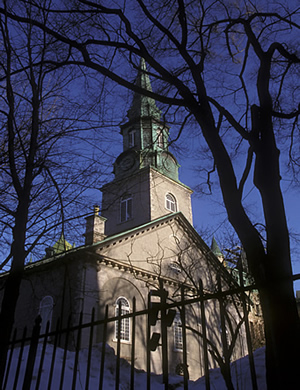 |
||
Quebec City |
Quebec City is unique, similar to how the adobe Santa Fe, New Mexico is unique in the United States. Quebec City is the only walled city in North America. Built by the French and reinforced by the British, it is 98% French speaking yet it has a thriving Irish and English population. One hundred thousand Irish immigrated here during the Great Potato Famine.
"We are the largest French-speaking metropolitan area in the English-speaking world," said Séguin. "Our city is a magnet for artists, performers, singers, artisans and adventurers. We Quebecois also love fine food. We're often referred to as North America's fine dining capital. In Old Quebec alone, we have over 100 enticing diners at every turn. And our access to the natural world is amazing."
Séguin is one of Quebec City's media directors. He's paid to provide good information about the city. Like any journalist—we were here with fellow members of the North American Snowsport Journalist Association—one approaches media directors with a measure of skepticism. That said, in our Quebec City stay, we found our skepticism unwarranted.
The village-like aspect to Quebec City is immediately evident with their charming, tight cobblestone streets, quaint indoor and outdoor cafes and shops, and their friendly people. The Old World stone masonry architectural blends in well with the New World wood structures. Parks and green spaces are abundant-well thought out by visionary settlers of the past and present. Among cities, their crime and birth rates are the lowest in North America. You feel safe, appreciated, pampered and comfortable here…just as one might in a small village.
QUEBEC CITY HISTORY
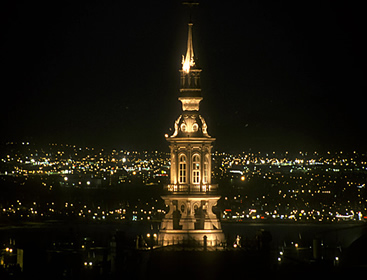 |
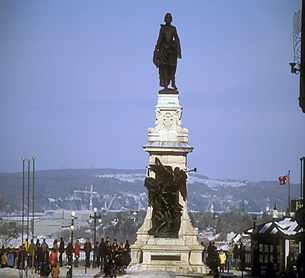 |
|
Night in Quebec City
|
Statue of explorer Champlain
|
Quebec City is one of North America's most historic and beautiful cities. Named after the Indian Algonquian word Kebec, it means the narrowing of the waters. Quebec City is where the St. Charles and St. Lawrence Rivers meet. The mighty St. Lawrence-only one kilometer wide here-was a flow of jigsaw puzzle like thaw ice during our late winter-early spring visit. Past Quebec City, the river widens considerably before it empties into the Atlantic 800 miles distant.
When French explorer Jacques Cartier came in 1535,only 100 natives lived along these banks. In 1608 Samuel de Champlain, another French explorer, set up a trading post. Quebec City quickly became the hub of New France. Vying interests from the Indian, British and upstart new Americans to the south, led Quebec City to being titled the "Gibraltar of Canada." It was besieged over six times.
British threats led the French to start building a medieval castle type wall around the natural promontory and rock terrain. In 1759, the British overtook the city in the Battle of the Plains of Abraham. Soon after, they built a citadel and a network of Martello towers—fully completed in 1832—to repel a 1775 attack by American generals Richard Montgomery and Benedict Arnold. It is the only citadel-city in North America to have preserved its fortifications. Quebec City became the capital of Canada's new Quebec Province in 1867. Though English traditions survive, Quebec City residents remain fiercely loyal to their francophone roots.
LE CHATEAU FRONTENAC
Like the Eiffel Tower is to Paris and the Statue of Liberty is o the USA, Le Chateau Frontenac is the symbol of Quebec City. It was the hotel of our Quebec City stay.
Built in1893, its 18 floors and 618 rooms dominate the Old Quebec City landscape. It overhangs the majestic St. Lawrence like an imposing medieval castle god. Notables such as FDR, Winston Churchill, Charles De Gaulle, Princess Grace and Charles Lindberg have stayed here. In 1943 and 1944, a good portion of the Allies' Normandy Invasion of WW11 was planned in the hotel.
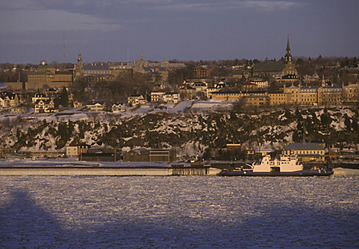 |
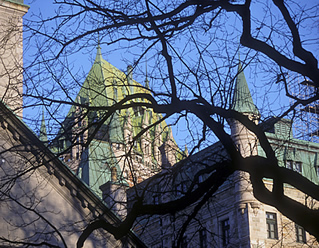 |
|
St. Lawrence River
|
Le Chateau Frontenac
|
The Chateau is a symbol of elegance and romance. The Chateau's Executive Chef Jean Soulard's cookbook Naturellement was awarded Cuisine Canada's lst Prize in literature recently. Fresh herbs used by Soulard and his staff is grown in gardens atop Le Chateau's roofs.
Drinking martinis with friends in the Chateau's conservatory one evening, we were startled at times by the moans and groans of spring icebergs as they moved past our window that looked down upon the St. Lawrence.
Icebreaker ships move up the St. Lawrence each spring to hasten the river's breakup in this zone that averages 12 feet of winter snow. With the breakup and approaching summer, 8000 commerce and tour ships a year come to Quebec along with 113 cruise ships, giving tourists a water approach to view this area which is on UNESCO's list as a World Heritage Site.
SPRING SKIING
A short drive from Quebec City is Mont-Saint-Anne, which boasts the longest ski season in the East with closures generally in early May. We delighted in the mountain's well-groomed snow along with some off-piste delectables.
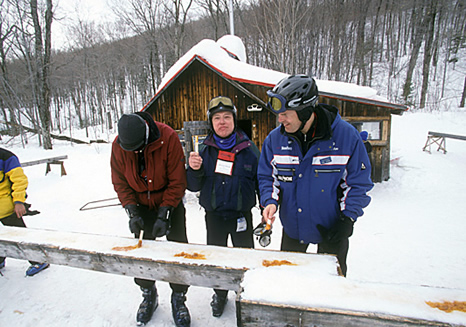 |
A run named La Pichard took us to a sugar shack-"cabane a sucre" in French--, a common site throughout Quebec, which produces 75% of the world's maple sugar. We took off our skis-though you don't have to-and bellied up to a wooden trough packed with fresh, white snow. The 'tire d'erable' or maple taffy is simply prepared by pouring hot maple syrup on the snow, letting it harden and then rolling it onto a Popsicle stick. Yummy! I think that the sugar hit provided me with an extra run or two that day. Mont-Sainte-Ann has Canada's largest cross-country ski center, second in North America to Royal Gorge in California's Tahoe region. |
|
Sugar Shack at Mont Sainte Anne
|
A run named La Pichard took us to a sugar shack—"cabane a sucre" in French— a common site throughout Quebec, which produces 75% of the world's maple sugar. We took off our skis—though you don't have to—and bellied up to a wooden trough packed with fresh, white snow. The "tire d'erable"' or maple taffy is simply prepared by pouring hot maple syrup on the snow, letting it harden and then rolling it onto a Popsicle stick. Yummy! I think that the sugar hit provided me with an extra run or two that day.
Mont-Sainte-Ann has Canada's largest cross-country ski center, second in North America to Royal Gorge in California's Tahoe region.
OLD QUEBEC CITY
Historic Old Quebec is where we stayed and explored. New Quebec City surrounds this venerable district of European charm and uncommon North American architecture. The hovering Le Chateau Frontenac commands upper Town of Old Quebec. Early aristocrats and military superiors occupied this area. Lower Town, along the banks of the St. Lawrence, belonged to the workers.
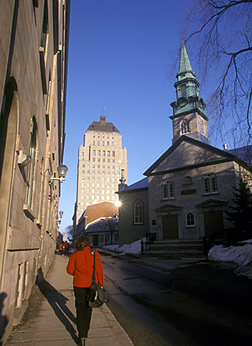 |
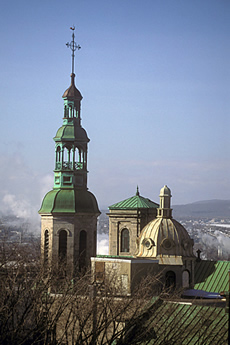 |
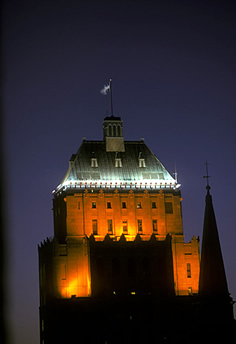 |
|
Old Quebec Walk
|
Basilica of Notre Dame
|
Quebec Province Parlament
|
One afternoon Quebec City guide Sharon Frenette took us on a stroll through Lower Town. She pointed out the church where scenes from Catch Me if You Can were photographed. "Now both Champlain and Tom Hanks have stayed here," she laughed. Later she would show us McDonalds with classy bronze arches. "We would not have those gaudy yellow arches here!" she exclaimed. Quebec City has more independent fine dining establishments—and fewer chains—than anywhere in Canada.
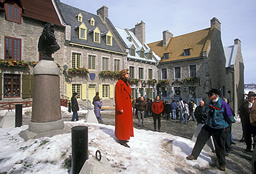 |
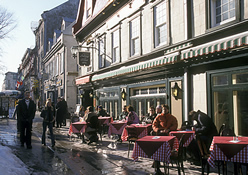 |
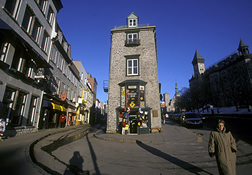 |
|||
|
Lower Tour |
Upper Town Cafe |
Upper Town Street |
Lower Town is filled with boutiques, antique shops, cafes and coffee houses. Rue Petit-Champlain is North America's oldest shopping street. Upper Town is a zone of horse drawn carriages (called caleches), stately old homes, serenading street musicians, art galleries, colorful taverns and spacious parks like the 235 acre Plains of Abraham, the ninth largest urban park in the world. "You don't need a Stairmaster here," said Frenette, "Just climb from Lower Town to Upper Town."
One of our fellow NASJA members Doug Pfeiffer—known throughout the world as the father of freestyle skiing—was born in Quebec City. Nostalgically, he recalled to us the days when he sailed across the Plains of Abraham on skis holding a bed sheet as a sail.
During a lunch break, we took an elevator to the top of Le Concorde Hotel and feasted on regional cuisine as the restaurant slowly turned—like the Space Needle in Seattle—offering mesmerizing views of the St. Lawrence, Quebec City streets and the Plains of Abraham. Le Concorde is one of Quebec City's taller buildings as there is a city ordinance preventing no structures above eleven stories. The city also has another unique ordinance, giving one zone of the city to graffiti artists. The graffiti in this allowed zone is world class. "We did it to keep unwanted graffiti off the streets and buildings," mentioned Frenette.
NATURAL QUEBEC CITY in SUMMER
Though ours was a spring visit, we have made a note to visit Quebec City in
the summer, their busiest season. It would be a great time to meld the cultural/culinary
with the natural.
Minutes away from Old Town are Parc de la Jacques-Cartier for canoeing and white water rafting. Within city limits is Montmorency Falls Park, a waterfall l00 feet higher than Niagara. Add this to cycling/incline skating paths, rock climbing, paragliding, mountain biking, fishing, water slides, wave pools and sailing possibilities. Then there's the 11-day Quebec City Summer Festival, a musical event of world beat and French song whereas Old Town Quebec becomes a musical stage. Car and Travel Magazine has called it "among the best-kept travel secrets in North America-and one of the best entertainment bargains in the world."
Time to end the story. I need to call my travel agent and arrange for a summer sojourn in this village.
USEFUL INFORMATION:
Quebec City Tourism Convention: 418-641-6654, fax 418-641-6578
Internet: www.quebecregion.com
Fairmont Le Chateau Frontonac: www.fairmont.com; 418-692-3861
Mont-Sainte-Anne: www.mont-sainte-anne.com; 1-800-463-1568
Prints may be purchased by contacting Larry at Skiturn789@yahoo.com.